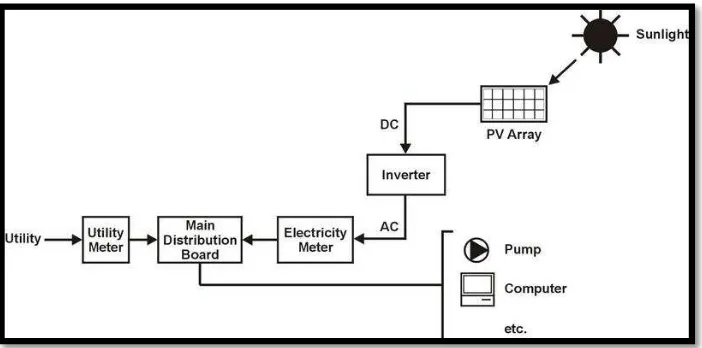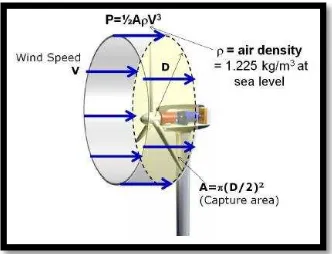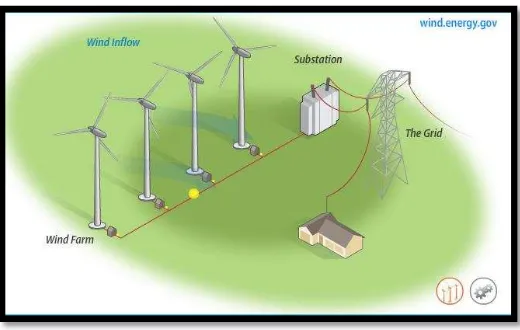POWER STABILITY OPTIMIZATION ON GRID CONNECTED WITH SOLAR AND WIND ENERGY HARVESTING
Noraina Binti Abdullah
“I hereby declare that I have read through this report entitle " Power Stability Optimization On Grid Connected with Solar and Wind Energy Harvesting" and found that it has comply the partial fulfillment for awarding the degree of bachelor of electrical Engineering (Industrial
Power).”
Signature :………..
Supervisor’s Name :……….
POWER STABILITY OPTIMIZATION ON GRID CONNECTED WITH SOLAR AND WIND ENERGY HARVESTING
NORAINA BINTI ABDULLAH
A report submitted in partial fulfillment of the requirements for the degree of Bachelor of Power Industry
Faculty of Electrical Engineering
UNIVERSITI TEKNIKAL MALAYSIA MELAKA
I declare that this report entitle “Power Stability Optimization on Grid Connected with Solar and Wind Energy Harvesting" is the result of my own research except as cited in the references. The report has not been accepted for any degree and is not concurrently submitted in candidature of any other degree.
Signature :………
Name :………
ACKNOWLEDGEMENT
Foremost I feel grateful to Allah SWT for giving me good health and lots of patience in completing my final year project. I would like to express my sincere gratitude to my supervisor En. Norhafiz bin Salim for the continuous support of my Bachelor Final Year Project, for his patience, motivation, enthusiasm, and immense knowledge. His guidance helped me in all time of undergraduate project and writing of this thesis. I could not have imagined having a better advisor and mentor for my Final Year Project.
My sincere thanks also goes to my lovely family which is the most important in my life for giving me support, both financially and emotionally throughout my degree. In particular, the patience and understanding shown by my parent during the honors year is greatly appreciated.
ABSTRACT
ABSTRAK
TABLES OF CONTENTS
CHAPTER TITLE PAGE
ACKNOWLEDGEMENT ii
ABSTRACT iii
TABLE OF CONTENTS v
LIST OF TABLES viii
LIST OF FIGURES ix
LIST OF ABBREVIATIONS xi
1 INTRODUCTION 1
1.1 Background 1
1.2 Problem Statement 2
1.3 Objectives 2
1.4 Scope 2
2 LITERATURE REVIEW 3
2.1 Introduction 3
2.2 Solar Energy System 3
2.2.1 Definition 3
2.2.2 Photovoltaic System (PV) 4
2.2.3 Operation 4
2.2.4 Advantage 5
2.3 Wind Energy System 5
2.3.1 Introduction 5
2.3.2 Power from Wind Turbine 5
2.3.3 Operation 6
2.3.4 Advantage 7
Power System
2.5 Summarization 8
3 METHODOLOGY 9
3.1 Introduction 9
3.2 Software Development 9
3.2.1 MATLAB Simulink 9
3.2.2 Power System Analysis Toolbox 10
(PSAT)
3.3 Utility Network Model 10
3.4 Simulation Design Software 12
3.4.1 PV System design Software 12
3.4.2 Wind Turbine System Design Software 12
3.5 Set Up Ideal Case 13
3.5.1 The Case with Fault 14
3.5.2 The Case with Fault and 14
Load Increasing
3.5.3 The Case with Solar PV Generator 15
3.5.4 The Case with Wind Turbine Generator 16
3.5.5 The Case with Solar PV-Wind Turbine 17
Hybrid Generator
3.5.6 Power Flow and Time Domain 18
4 RESULT AND DISCUSSION 19
4.1 Introduction 19
4.2 Solar PV system performance 19
4.2.1 Speed of Synchronous Generator 19
Performance
4.2.2 Voltage Bus Performance 21
4.2.3 Real Power Performance 22
4.2.4 Reactive Power Performance 22
4.3 Wind Turbine System Performance 23
4.3.1 Speed of Synchronous Generator 23
4.3.3 Real Power Performance 25
4.3.4 Reactive Power Performance 27
4.4 PV-Wind Turbine Hybrid System Performance 28
4.4.1 Speed of Synchronous Generator 28
Performance
4.4.2 Voltage Bus Performance 29
4.4.3 Real Power Performance 30
4.4.4 Reactive Power Performance 31
5 ANALYSIS AND DISCUSSION 33
5.1 Introduction 33
5.2 Summarize of performance 33
6 CONCLUSION AND RECOMMENDATIONS 36
REFERENCE 38
LIST OF TABLES
TABLE TITLE PAGE
3.1 14-dynamic bus network statistics 11
3.2 Parameter of Wind Turbine generator 13
3.5 Parameter of each load applied 15
4.1 Result when PV is applied with fault and addition load occur 21
4.2 Voltage at bus 2 23
4.3 Speed of synchronous generator 2 24
4.4 Voltage at bus 2 25
4.5 Real power of synchronous Generator 1 25
4.6 Reactive power of synchronous generator 1 27
4.7 Speed of synchronous generator 2 28
4.8 Real Power of Synchronous Generator 30
LIST OF FIGURES
FIGURE TITLE PAGE
2.1 The flow of block diagram operation of PV 4
2.2 The power available from wind 6
2.3 Wind speed, Power & height 6
2.4 The operation of wind turbine connected to grid 7
3.1 PSAT window Version 2.1.8 10
3.2 The 14-bus network dynamic system 11
3.3 Type of solar Photovoltaic generator 12
3.4 Type of wind turbine generator 13
3.5 Fault is applied at bus 2 14
3.6 Load is applied at bus 9, 13 and 14 with Fault occur at bus 2 15
3.7 The integration of the solar to grid at bus 2 16
3.8 Wind Turbine applied to 14-bus grid network with Fault and 17
Load increasing
3.9 14-bus grid network with wind turbine generator and PV 18
Generator that instability state due fault and load increasing
4.1 (a) Speed of Synchronous Generator performance with PV 20
4.1 (b) Speed of Synchronous Generator performance with PV 20
System connected
4.2 Voltage Bus Performance with PV system connected 21
4.3 Real Power of Synchronous generator 22
4.4 Reactive Power of synchronous generator 23
4.5 Speed of synchronous generator 24
4.6 a) Voltage at bus 2 25
4.6 b) Voltage at bus 2 25
4.7 Real power of Synchronous generator 1 26
4.8 Reactive Power of synchronous generator 1 27
4.9 Speed of synchronous generator 2 28
4.10 a) Voltage at bus 2 29
4.10 b) Voltage at bus 2 29
4.11 Real Power of synchronous generator 1 30
4.12 a) Reactive Power of Synchronous generator 1 31
LIST OF SYMBOLS
P - Power
A - Capture Area
V - Wind Speed
- Air density (1.225 kg/ )
MW - Mega Watt
V - Voltage
s - Seconds
t - Time
PV - Photovoltaic
CHAPTER 1
INTRODUCTION
1.1 Background
Stability is the tendency of power system to develop restoring forces equal to or greater than the disturbing forces to keep the state of equilibrium. If the forces tending to hold machines in synchronism with one another are enough to overcome the disturbing forces, the system is said to remain stable. The stability studies is separated into two major parts which is steady state stability and transient stability. Steady state stability is ability of electrical system to recover synchronism after small and slow disturbance, such as changes of gradual power. Transient stability is to remain synchronism when sudden disturbances, such as three-phase fault, the sudden outage of line or the sudden addition or removal of loads. As the usage of electricity increases every year will lead to instability of power system due to increasing of loads. Thus, to overcome the instability of the power system, there are many ways has been applied which can improve the power stability which is applying FACTS controller to AC power, and other electricity generation like oil and coal and etc.
combining wind turbine with solar electricity to the grid network.
1.2 Problem Statement
The existing transmission lines are built 20 years ago. Due to ageing and other related factors, it is unreliable in future. Furthermore, fast going technologies and increasing number of population will result in possibility of overload problem. Thus, a new transmission lines with use of renewable energy power sources such as solar and wind energy to it. This to support the usage of renewable energy and is estimated to last for the next 20 years to ensure stability of the system on grid connection.
1.3 Objectives
The objectives of this project are:
1. To investigate the operation of solar and wind power systems.
2. To design hybrid PV and wind system using PSAT software which is using MATLAB
Simulink.
3. To verify the optimization power of solar and wind energy harvesting.
4. To analyze the performance of Solar PV and wind energy system.
1.4 Scope
CHAPTER 2
LITERATURE REVIEW
2.1 INTRODUCTION
This chapter will discussed about the solar and wind energy harvesting. A brief definition of solar and wind energy will be explained and the basic operation of this both system also will be discussed in this topic. In addition, a few theory regarding FACTS for Grid integration of wind power also will be included.
2.2 SOLAR ENERGY SYSTEM
2.2.1 Definition
Power generating system which is from a type of renewable energy is known as PV system. This PV module or PV panel is function as convert the direct ray from the sunlight to electricity. This photovoltaic PV module will used semiconductor as converting the solar radiation into direct current (DC) electricity.
2.2.3 Operation
In understanding on how the photovoltaic PV system work when a grid-connected to PV is includes a few component that will work together. Figure 2.1 shows flow of block diagram operation of PV. The amount of sunlight which direct ray that hits the panel will generate electricity. Then, direct current (DC) electricity will produced and the inverter that connected to the grid will convert the DC into AC electricity. Thus, the AC electricity can be used to utility. As we know that the solar cell only can produce power during the day, the main power grid will supply power as usual.
2.2.4 Advantage of Solar Energy System
The advantage of using solar energy power system in electricity is this system is renewable energy, and easy to get which means that free source, only receive energy from the sunlight. In addition, solar energy system is long life span (durable).
2.3 WIND ENERGY SYSTEM
2.3.1 Introduction
Wind turbines can be divided into three parts which is small, medium, and large turbine [7]. The output power rating of small turbines is less than 20kW which are used for residential application. For the medium turbines, the output rating provide around 20 to 300kW which installed power that used to supply either remote loads that need more electrical power or commercial building. On the other hand, the power range of the large turbine are MW which in corporate complex system and wind farm. By the way, the parameter wind plant that was set up is 5kW [2]. Compared to the wind turbine that connected to the point of common coupling (PCC) is 1.5kW.
2.3.2 Power from Wind Turbine
The power produce by wind turbine is depend on blades, height, velocity of wind and etc. Thus, the equation below shows how to calculate power that produce from wind turbine. The Figure 2.2 illustrate the power available from the wind and Figure 2.3 shows wind speed, Power, & height.
(2.1)
= air density (1.225 kg/ )
Figure 2.2: The power available from the wind
Figure 2.3: Wind speed, Power, & height
2.3.3 Operation
[image:21.595.192.401.377.545.2]connected with rotor will spins a generator. The most energy which captured by the wind turbine are mounted on a tower. Figure 2.4 shows the operation of wind turbine connected to the grid. Faster and less turbulent wind at 100 feet or more above ground.
Figure 2.4: The operation of wind turbine connected to the grid
2.3.4 Advantage
The advantages of used wind energy system is free source and ability to capture efficiently. Furthermore, this energy system is friendly to the surrounding environment. In addition, when combined with solar electricity, this energy source is great for developed and developing countries to provide a steady, reliable supply of electricity.
2.4 FACTS controller and Hybrid Renewable Power System
CHAPTER 3
METHODOLOGY
3.1 Introduction
In order to make the progress of this project work smoothly, this chapter will explain more detail about the methodology that has been used to complete this project. This may include from the project has been started until this project is complete all relevant experimental and descriptive techniques used in this project will be outlined. This methodology will used and helps as guidelines to get good result. Besides that it can help this project in solving problem and can be completed step by step as scheduled.
3.2 Software Development
3.2.1 MATLAB Simulink


